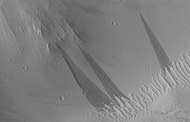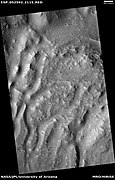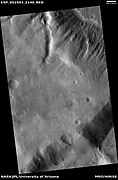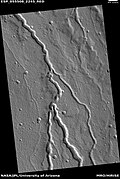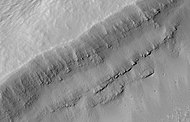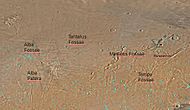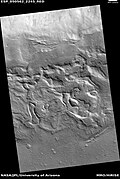Arcadia quadrangle
| MC-03 | Arcadia | 30–65° N | 60–120° W | Quadrangles | Atlas |
The Arcadia quadrangle is full of many features that are were discovered with satellites which went in orbit about the planet. Ridge networks, glaciers, dust devil tracks, slope streaks, gullies, latitude dependent mantle, old river channels, and huge troughs are shown and described in this article. We have learned so much about the Red Planet in the nearly half century of study with satellites that went to Mars. The quadrangle contains Alba Patera, the largest volcano (by area) in the solar system, Mareotis Fossae, Tempe Fossae, and Tempe Terra, a highly fractured block of ancient crust about the size of Alaska. The Arcadia quadrangle is one of a series of 30 quadrangle maps used by the United States Geological Survey (USGS) . The quadrangle is located in the northern hemisphere of Mars and covers 30° to 65° north latitude and 60° to 120° west longitude (300° to 240° east longitude) and 30° to 65°. The Arcadia quadrangle is also referred to as MC-3 (Mars Chart-3).[1] The southern border of the Arcadia quadrangle is approximately 3,065 km while and northern border is about 1,500 km wide. The north to south distance is about 2,050 km (slightly less than the length of Greenland).[2]
Contents
Origin of Name
Arcadia is the name of a classical albedo feature located at 45° north latitude (N) and 260° east longitude (E) on Mars. The feature was named after a mountainous region in southern Greece.[3] The name was approved by the International Astronomical Union(IAU) in 1958.[4]
Fossa
Large troughs (long narrow depressions) are called fossae in the geographical language used for Mars. This term is derived from Latin; therefore fossa is singular and fossae is plural.[5] Troughs form when the crust is stretched until it breaks. The stretching is from the large weight of a nearby volcano. Fossae/pit craters are common near volcanoes in the Tharsis and Elysium system of volcanoes.[6] A trough often has two breaks with a middle section moving down, leaving steep cliffs along the sides; such a trough is called a graben.[7] Lake George, in northern New York State, is a lake that sits in a graben. Pit craters are often associated with graben. Pit craters do not have rims or ejecta around them, like impact craters do. Studies have found that on Mars a fault may be as deep 5 km, that is the break in the rock goes down to 5 km. Moreover, the crack or fault sometimes widens or dilates. This widening causes a void to form with a relatively high volume. When surface material slides into the void, a pit crater or a pit crater chain forms. On Mars, individual pit craters can join to form chains or even to form troughs that are sometimes scalloped.[8] Other ideas have been suggested for the formation of fossae and pit craters. There is evidence that they are associated with dikes of magma. Magma might move along, under the surface, breaking the rock and more importantly melting ice. The resulting action would cause a crack to form at the surface. Pit craters are not common on Earth.[9] Knowledge of the locations and formation mechanisms of pit craters and fossae is important for the future colonization of Mars because they may be reservoirs of water.[10] Many grabens are found in the Arcadia quadrangle. Pictures below show examples of grabens (Fossa) in Arcadia.
Graben near Alba Patera, as seen by THEMIS. Graben and catenae, collapse features, both caused by faults. When the crust is stretched, faults form and material falls into voids created by the stretching. Uranius Tholus (upper) and Ceraunius Tholus (largest) volcanoes are visible in wide context view, below and to the right of Alba Patera.
Forces from different directions caused this complex of grabens to form. Picture taken by THEMIS.
Mareotis Fossae Region, as seen by HiRISE.
Tempe Fossae Sinuous Channel, as seen by HiRISE.
Straight trough is a fossa that would be classified as a graben. Curved channels may have carried lava/water from the fossa. Picture taken with HiRISE under HiWish program.
Troughs with dark slope streaks, as seen by HiRISE under HiWish program
Dust devil tracks
Many areas on Mars, including the Arcadia quadrangle, experience the passage of giant dust devils. A thin coating of fine bright dust covers most of the Martian surface. When a dust devil goes by it blows away the coating and exposes the underlying dark surface. Dust devils have been seen from the ground and from orbit. They have even blown dust from the solar panels of the two Mars Exploration Rovers (Spirit, Opportunity) on Mars, thereby greatly extending their lives.[11] The twin Rovers were designed to last for 3 months, instead they have lasted many years. Opportunity Rover lasted over 14 years. The pattern of the tracks have been shown to change every few months.[12] It must be pointed out that it does not take too much fine dust to cover those tracks--experiments in Earth laboratories demonstrate that only a few 10's of microns of dust will be enough. The width of a single human hair ranges from approximately 20 to 200 microns (μm); consequently, the dust that can cover dust devil tracks may only be the thickness of a human hair.[13] The image below from HiRISE shows some dust devil tracks in the shape of X's. You may need to click on the image for a larger view to see the tracks clearly.
Tantalus Fossae, as seen by HiRISE. Click on image to see dust devil tracks.
Dark slope streaks
Many places on Mars show dark streaks on steep slopes like crater walls. The youngest streaks are dark; then they become lighter with age. Often they begin as a small narrow spot then widen and extend downhill for hundreds of meters. They have been seen to travel around obstacles, like boulders.[14] It is most generally accepted that they represent avalanches of dust. The streaks appear in areas covered with dust. When a thin layer of dust is removed, the underlying surface is dark. Much of the Martian surface is covered with dust. Fine dust settles out of the atmosphere covering everything. We know a lot about this dust because the solar panels of the Mars Rovers get covered with dust, thus reducing the electrical energy.[15] Dust storms are frequent, especially when the spring season begins in the southern hemisphere. At that time, Mars is 40% closer to the sun. The orbit of Mars is much more elliptical then the Earth's. That is the difference between the farthest point from the sun and the closest point to the sun is very great for Mars, but only a slight amount for the Earth. Also, every few years, the entire planet is engulfed in a global dust storm. When NASA's Mariner 9 craft arrived there, nothing could be seen through the dust storm.[16] [17] Other global dust storms have also been observed, since that time. Research, published in January 2012 in Icarus, found that dark streaks were initiated by airblasts from meteorites traveling at supersonic speeds. The team of scientists was led by Kaylan Burleigh, an undergraduate at the University of Arizona. After counting some 65,000 dark streaks around the impact site of a group of 5 new craters, the team saw clear patterns. The number of streaks was greatest closer to the impact site. So, the impact somehow probably caused the streaks. Also, the distribution of the streaks formed a pattern with two wings extending from the impact site. The curved wings resembled scimitars, curved knives. This pattern suggests that an interaction of airblasts from the group of meteorites shook dust loose enough to start dust avalanches that formed the many dark streaks. At first it was thought that the shaking of the ground from the impact caused the dust avalanches, but if that was the case the dark streaks would have been arranged symmetrically around the impacts, rather than being concentrated into curved shapes.[18] [19] Dark streaks can be seen in the images below that was taken by HiRISE.
Tractus Catena, as seen by HiRISE. Scale bar is 1,000 meters long. Click on image for good view of dark slope streaks.
Trough with dark slope streaks, as seen by HiRISE under HiWish program
Martian gullies
Some excellent examples of Martian gullies are found tin the arcadia quadrangle. Gullies occur on steep slopes, especially on the walls of craters. Gullies are believed to be relatively young because they have few, if any craters. Moreover, they lie on top of sand dunes which themselves are considered to be quite young. Usually, each gully has an alcove, channel, and apron.[20] Gullies were once thought to be caused by recent flowing water. However, with further extensive observations with HiRISE, it was found that many are forming/changing today, even though liquid water cannot exist under current Martian conditions. Faced with these new observations, scientists came up with other ideas to explain them. The consensus seems to be that although water may have helped form them in the past, today they are being produced by chunks of dry ice moving down steep slopes. [21] [22] [23] Repeated observations of gullies that were changing today revealed that they changing in the season when dry ice would be most likely be breaking up and moving down slopes. The movement would be aided by carbon dioxide lifting/lubricating the chunks of dry ice
A variety of gullies originating at different levels are visible in this HiRISE image that was taken under the HiWish program.
Gullies along mesa wall in North Tempe Terra, as seen by HiRISE under HiWish program
Latitude dependent mantle
Much of the surface of Mars is covered by a thick smooth mantle that is thought to be a mixture of ice and dust. This ice-rich mantle, a few yards thick, makes the surface look very smooth. Because there are few craters on this mantle, the mantle is relatively young. Mantle falls from the air during certain climates. Changes in Mars's orbit and tilt cause significant changes in the distribution of water ice from Polar Regions down to latitudes equivalent to Texas. During certain climate periods, water vapor leaves polar ice and enters the atmosphere. The water returns to the ground at lower latitudes as deposits of frost or snow mixed generously with dust. The atmosphere of Mars contains a great deal of fine dust particles. Water vapor condenses on the particles, and then they fall down to the ground due to the additional weight of the water coating. When ice at the top of the mantling layer goes back into the atmosphere, it leaves behind dust, which insulates the remaining ice.[24] [25] Lobate convex features on the surface known as viscous flow features and lobate debris aprons regarded as true glaciers.[26] [27] [28] [29] [30] [31] [32] [33]
View of lobate debris apron along a slope. Lobate debris aprons are considered to be glaciers covered with a layer of debris. Image located in Arcadia quadrangle.
Channels
Many places on Mars show channels of different sizes. Many of these channels probably carried water, at least for a time. The climate of Mars may have been such in the past that water ran on its surface.
Perepelkin (Martian crater), as seen by CTX camera (on Mars Reconnaissance Orbiter).
Dipping layers
Dipping groups of layers along slopes, especially along crater walls are believed to be the remains of a once wide spread material that has mostly been eroded away.[34]
Linear ridge networks
Linear ridge networks are found in various places on Mars in and around craters.[35] These features have also been called "polygonal ridge networks," "boxwork ridges", and "reticulate ridges."[36] Ridges often appear as mostly straight segments that intersect in a lattice-like manner. They are hundreds of meters long, tens of meters high, and several meters wide. One popular idea for their formation is that impacts created fractures in the surface, these fractures later acted as channels for fluids. Fluids became hard. With the passage of time, surrounding material was eroded away, thereby leaving hard ridges behind. However, we do not yet agree on the exact cause.
Layers
Many places on Mars show rocks arranged in layers. Rock can form layers in a variety of ways. Volcanoes, wind, or water can produce layers.[37] A detailed discussion of layering with many Martian examples can be found in Sedimentary Geology of Mars.[38]
Layers, as seen by HiRISE under HiWish program Location is Tempe Terra
Layers, as seen by HiRISE under HiWish program Location is Tempe Terra Note: this is an enlargement of the previous image.
Other Features in the Arcadia quadrangle
Double crater, as seen by HiRISE under HiWish program
Enipeus Vallis, as seen by HiRISE. Scale bar is 500 meters long.
Artynia Catena, as seen by HiRISE. Scale bar is 1000 meters long.
Map showing location of Barabashov Crater and other nearby craters.
See also
External links
References
- ↑ Davies, M.E.; Batson, R.M.; Wu, S.S.C. "Geodesy and Cartography" in Kieffer, H.H.; Jakosky, B.M.; Snyder, C.W.; Matthews, M.S., Eds. Mars. University of Arizona Press: Tucson, 1992.
- ↑ Distances calculated using NASA World Wind measuring tool. http://worldwind.arc.nasa.gov/.
- ↑ Blunck, J. 1982. Mars and its Satellites. Exposition Press. Smithtown, N.Y.
- ↑ USGS Gazetteer of Planetary Nomenclature. Mars. http://planetarynames.wr.usgs.gov/.
- ↑ http://www.marsartgallery.com/marsnames.html
- ↑ Skinner, J., L. Skinner, and J. Kargel. 2007. Re-assessment of Hydrovolcanism-based Resurfacing within the Galaxias Fossae Region of Mars. Lunar and Planetary Science XXXVIII (2007)
- ↑ http://hirise.lpl.arizona.edu/PSP_008641_2105
- ↑ Wyrick, D., D. Ferrill, D. Sims, and S. Colton. 2003. Distribution, Morphology and Structural Associations of Martian Pit Crater Chains. Lunar and Planetary Science XXXIV (2003)
- ↑ http://www.msss.com/mars_images/moc/2004/01/29/index.html
- ↑ Ferrill, D., D. Wyrick, A. Morris, D. Sims, and N. Franklin. 2004. Dilational fault slip and pit chain formation on Mars 14:10:4-12
- ↑ http://marsrovers.jpl.nasa.gov/gallery/press/spirit/20070412a.html
- ↑ http://https://web.archive.org/web/20111028015730/http://mars.jpl.nasa.gov/spotlight/kenEdgett.html |
- ↑ https://en.wikipedia.org/wiki/Micrometre
- ↑ http://www.space.com/image_of_day_080730.html
- ↑ https://www.sciencedaily.com/releases/2009/02/090217101110.htm%7Caccess-date=2017-06-01%7Cdate=2009-02-19%7Ctitle=Mars Spirit Rover Gets Energy Boost From Cleaner Solar Panels|work=Science Daily}}
- ↑ {{Cite book |isbn = 0-517-00192-6|title = Atlas of the Solar System|last1 = Moore|first1 = Patrick|
- ↑ Hugh H. Kieffer|title=Mars|url=https://books.google.com/books?id=NoDvAAAAMAAJ%7Caccessdate=7 March 2011|year=1992|publisher=University of Arizona Press|
- ↑ Burleigh | first1 = Kaylan J. | last2 = Melosh | first2 = Henry J. | last3 = Tornabene | first3 = Livio L. | last4 = Ivanov | first4 = Boris | last5 = McEwen | first5 = Alfred S. | last6 = Daubar | first6 = Ingrid J. | year = 2012 | title = Impact air blast triggers dust avalanches on Mars | url = | journal = Icarus | volume = 217 | issue = 1| page = 194 | doi = 10.1016/j.icarus.2011.10.026 |
- ↑ http://redplanet.asu.edu/
- ↑ Edgett |first1= K. |last2= Malin |first2= M. C. |last3= Williams |first3= R. M. E. |last4= Davis |first4= S. D. |date= 2003 |title= Polar-and middle-latitude martian gullies: A view from MGS MOC after 2 Mars years in the mapping orbit |journal= Lunar Planet. Sci. |volume=34 |at=p. 1038, Abstract 1038 | url=http://www.lpi.usra.edu/meetings/lpsc2003/pdf/1038.pdf |
- ↑ Harrington |first=J.D. |last2=Webster |first2=Guy |title=RELEASE 14-191 – NASA Spacecraft Observes Further Evidence of Dry Ice Gullies on Mars |url=http://www.nasa.gov/press/2014/july/nasa-spacecraft-observes-further-evidence-of-dry-ice-gullies-on-mars |date=July 10, 2014 |work=NASA
- ↑ CNRS. "Gullies on Mars sculpted by dry ice rather than liquid water." ScienceDaily. ScienceDaily, 22 December 2015. www.sciencedaily.com/releases/2015/12/151222082255.htm
- ↑ http://www.skyandtelescope.com/astronomy-news/martian-gullies-triggered-by-exploding-dry-ice-122320158
- ↑ https://www.sciencedaily.com/releases/2003/12/031218075443.htm </ref
Glacial features
Glaciers, loosely defined as patches of currently or recently flowing ice, are thought to be present across large areas of the modern Martian surface, and are inferred to have been more widely distributed at times in the past.<Carr>"The Surface of Mars" Series: Cambridge Planetary Science (No. 6) ISBN|978-0-511-26688-1 Michael H. Carr, United States Geological Survey, Menlo Park
- ↑ Hugh H. Kieffer (1992). Mars. University of Arizona Press. ISBN 978-0-8165-1257-7.
- ↑ Milliken | first1 = R. E. | last2 = Mustard | first2 = J. F. | last3 = Goldsby | first3 = D. L. | year = 2003 | title = Viscous flow features on the surface of Mars: Observations from high-resolution Mars Orbiter Camera (MOC) images | url = https://semanticscholar.org/paper/a822f14644d2294b948e101be2f294ac33b57ec3%7C journal = Journal of Geophysical Research | volume = 108 | issue = E6| page = 5057 |
- ↑ Squyres | first1 = S.W. | last2 = Carr | first2 = M.H. | year = 1986 | title = Geomorphic evidence for the distribution of ground ice on Mars | url = | journal = Science | volume = 213 | issue = 4735| pages = 249–253 | doi = 10.1126/science.231.4735.249 | pmid = 17769645 |
- ↑ Head | first1 = J.W. | last2 = Marchant | first2 = D.R. | last3 = Dickson | first3 = J.L. | last4 = Kress | first4 = A.M. | year = 2010 | title = Criteria for the recognition of debris-covered glacier and valley glacier landsystem deposits | url = | journal = Earth Planet. Sci. Lett. | volume = 294 | issue = | pages = 306–320 | doi=10.1016/j.epsl.2009.06.041 |
- ↑ Holt | first1 = J.W. |display-authors=et al | year = 2008 | title = Radar sounding evidence for buried glaciers in the southern mid-latitudes of Mars | url = | journal = Science | volume = 322 | issue = 5905| pages = 1235–1238 | doi=10.1126/science.1164246 | pmid=19023078|
- ↑ Morgan | first1 = G.A. | last2 = Head | first2 = J.W. | last3 = Marchant | first3 = D.R. | year = 2009 | title = Lineated valley fill (LVF) and lobate debris aprons (LDA) in the Deuteronilus Mensae northern dichotomy boundary region, Mars: Constraints on the extent, age and episodicity of Amazonian glacial events | url = | journal = Icarus | volume = 202 | issue = 1| pages = 22–38 | doi=10.1016/j.icarus.2009.02.017 |
- ↑ Plaut | first1 = J.J. | last2 = Safaeinili | first2 = A. | last3 = Holt | first3 = J.W. | last4 = Phillips | first4 = R.J. | last5 = Head | first5 = J.W. | last6 = Sue | first6 = R. | last7 = Putzig | first7 = A. | year = 2009 | title = Frigeri Radar evidence for ice in lobate debris aprons in the mid-northern latitudes of Mars | url = https://semanticscholar.org/paper/f6b94761e6a276ce6894374ae9bea88fdc3e5e19%7C journal = Geophys. Res. Lett. | volume = 36 | issue = 2| page = L02203 | doi=10.1029/2008gl036379|
- ↑ Baker | first1 = D.M.H. | last2 = Head | first2 = J.W. | last3 = Marchant | first3 = D.R. | year = 2010 | title = Flow patterns of lobate debris aprons and lineated valley fill north of Ismeniae Fossae, Mars: Evidence for extensive mid-latitude glaciation in the Late Amazonian | url = | journal = Icarus | volume = 207 | issue = 1| pages = 186–209 |
- ↑ Arfstrom | first1 = J. | year = 2005 | title = Terrestrial analogs and interrelationships | url = | journal = Icarus | volume = 174 | issue = 2| pages = 321–335 | doi=10.1016/j.icarus.2004.05.026 |
- ↑ Carr | first1 = M | year = 2001 | title = Mars Global Surveyor observations of martian fretted terrain | url = | journal = J. Geophys. Res. | volume = 106 | issue = | pages = 23571–23593 |
- ↑ Head, J., J. Mustard. 2006. Breccia dikes and crater-related faults in impact craters on Mars: Erosion and exposure on the floor of a crater 75 km in diameter at the dichotomy boundary, Meteorit. Planet Science: 41, 1675-1690.
- ↑ Moore, J., D. Wilhelms. 2001. Hellas as a possible site of ancient ice-covered lakes on Mars. Icarus: 154, 258-276.
- ↑ http://hirise.lpl.arizona.edu?PSP_008437_1750 |title=HiRISE | High Resolution Imaging Science Experiment |publisher=Hirise.lpl.arizona.edu?psp_008437_1750 |
- ↑ Grotzinger, J. and R. Milliken (eds.). 2012. Sedimentary Geology of Mars. SEPM.

















